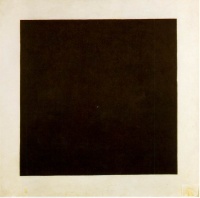Russian avant-garde
From The Art and Popular Culture Encyclopedia
|
Related e |
|
Featured: |
The Russian avant-garde is an umbrella term used to define the large, influential wave of modern art that flourished in Russia from approximately 1890 to 1930 - although some place its beginning as early as 1850 and its end as late as 1960. The term covers many separate, but inextricably related, art movements that occurred at the time; namely Symbolism, neo-primitivism, suprematism, constructivism, and futurism. Given that many of these avant-garde artists were born or grew up in what is a present-date Ukraine (including Kazimir Malevich, Aleksandra Ekster, Vladimir Tatlin, Wassily Kandinsky, David Burliuk, Alexander Archipenko), some sources also talk about Ukrainian avant-garde.
The Russian avant-garde reached its creative and popular height in the period between the Russian Revolution of 1917 and 1932, at which point the ideas of the avant-garde clashed with the newly emerged state-sponsored direction of Socialist Realism. Notable figures from this era include:
Artists and Designers
- Nathan Altman
- Marc Chagall
- Vladimir Baranoff-Rossine
- David Burliuk
- Ilya Casnik
- Aleksandra Ekster
- Pavel Filonov
- Naum Gabo
- Natalia Goncharova
- Anna Kagan
- Wassily Kandinsky
- Ivan Kliun
- Gustav Klutsis
- El Lissitzky
- Kazimir Malevich
- Michael Matjuschin
- Vadim Meller
- Solomon Nikritin
- Liubov Popova
- Kliment Red'ko
- Alexander Rodchenko
- Olga Rozanova
- Léopold Survage
- Varvara Stepanova
- Georgii and Vladimir Stenberg
- Vladimir Tatlin
- Vasiliy Yermilov
- Nadezhda Udaltsova
- Alexandr Zhdanov


